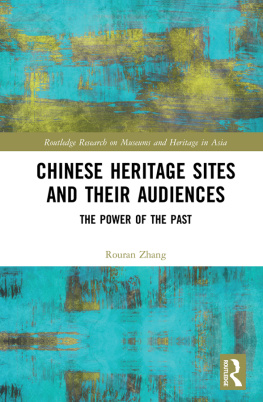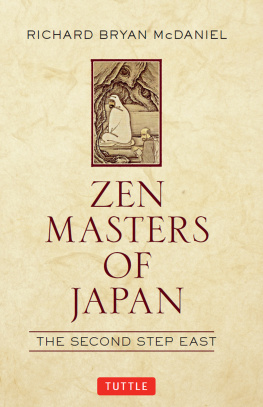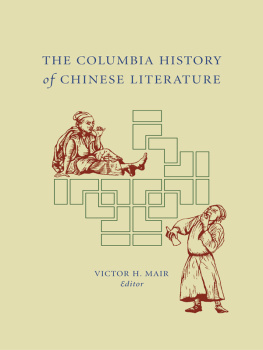Table of Contents
Foreword to the New Edition
FOR EVERYONE interested and intrigued, whether from the standpoint of scholarly research or experiential practice, by the early history of the quixotic yet inspirational teachings of Chan Buddhism in China extending from the end of the fifth through the thirteenth centuries that set the stage for the later development of Zen in Japan, it is gratifying to have in print this revised edition of Zens Chinese Heritage, impeccably translated by Andy Ferguson. As a perennial seeker of knowledge who has traveled extensively to ancient temples and sacred mountains as well as to modern universities and institutions of learning throughout China, and who has poured over the classical texts of the tradition for many years, Ferguson is ideally suited to the project of putting forth in English some of the most importantand, unfortunately, mostly neglectedmaterials about the formation and legacy of the Chan school. And this book is an ideal introduction to the topic and a volume that will be read and reread for many years. This new edition has significantly enhanced sections on Dayi Daoxuan, Huineng, and Baizhang Huaihai.
The Chan sayings translated in this volume, including dialogues, anecdotes, parables, epigrams, and gongan (Japanese: kan ) are primarily taken from the crucial collection called Wudeng Huiyuan ( Compendium of Five Lamps ). This collection, which dates from the mid-1200s, is a distillation by the monk Puji located at the major Lingyin Monastery in the Southern Song capital of Hangzhou of five previously composed transmission of the lamp records. These lamp records (based on the model of the Biographies of Eminent Monks , which had an edition issued in 988) began to be compiled at the beginning of the eleventh century, and gathered together the main sayings associated with particular teachers by following a generation-by-generation sequence that accommodates the multiple branches (the five houses and seven streams) of the Chan lineage. Because some of the stories contained in the earlier lamp records (particularly in the initial masterpiece of the genre, The Record of the Transmission of the Lamp of the Jingde Era ) were sometimes left out of the Wudeng Huiyuan , Ferguson knowledgeably and appropriately supplements his translations in this volume with materials from these earlier texts.
One of the great benefits of this book is the way that Ferguson organizes the twenty-five generations of Chan masters into three main periods. The first is the Legendary Period (480755), which covers the time from founding patriarch Bodhidharma through the direct disciples of sixth patriarch Huineng in the seventh generation. During this phase, the actual sense of historiography is rather sketchy and stories mixing myth and magic are blended with more philosophical fare. The second period is the Classical Period (755950), that is, from the middle of the Tang dynasty until around the dawn of the Song dynasty, when the Southern school known for its blasphemous rhetoric and iconoclastic antics became prominent along with several other collateral lineages. Finally, there is the Literary Period (9501260), when the records of the Chan masters sayings, which were initially probably oral teachings sometimes transcribed into notes by dedicated disciples, were composed and expanded into the recorded sayings ( yulu ) and paradigmatic cases or gongan .
The Wudeng Huiyuan , the text from which Zens Chinese Heritage is primarily drawn, is in many ways the pinnacle of the tradition of accumulating the teachings of diverse masters set in various genres of transmission of the lamp records, recorded sayings of individual teachers, and gongan collections. Many of the sayings here are familiar to readers from other sources, sometimes in slightly different versions, which is itself an issue that is enjoyable and challenging to sort out. The Compendium of Five Lamps is an incredibly rich resource that is very deserving of this new edition.
Steven Heine
Florida International University
Miami, Florida
STEVEN HEINE is professor and director of Asian Studies at Florida International University. He has published over twenty books dealing with the history and thought of Zen Buddhism as well as contemporary East Asian religiosity, including Did Dogen Go to China? What He Wrote and When He Wrote It and Zen Skin, Zen Marrow: Will the Real Zen Buddhism Please Stand Up?
Foreword
THANKS TO the incomparably kind and careful efforts of Andy Ferguson and his skillful collaborators, we now have before us this wonderful collection of sublime Zen stories. These stories are essentially concerned with enlightened compassion, for the ultimate intention of Zen teaching and training is to develop a profound insight that purifies our love and devotion to all living beings. Zen is part of the Mahayana, the Great Vehicle, the universal movementthe movement of the universewhich is fundamentally committed to liberating all living beings from suffering and working to realize their greatest happiness. When our compassion is purified and has no limits we can work together with all beings for the welfare of all.
In order to liberate beings from suffering it is necessary to realize its origin. What is the origin of suffering? Although it has been taught many times and in many different ways, clinging to our deluded stories of who and what we are is the origin of our suffering. Clinging to the idea that we are really separate from each other is our deluded story of the self. Therefore, if we want to work most effectively for the welfare of all beings, we must forget all about our own stories. If we wish to understand Buddhas liberating teaching, we must completely let go of our own narrative about reality.
The stories presented here for our study and inquiry offer virtually endless opportunities to free ourselves from our habitual stories. The shift from our habitual stories of the self to new ones is part of the process of liberation, but it does not stop there; we must even go beyond such liberation. Its not that the old stories are delusion and the new ones are enlightenment; rather its that clinging to the old stories is deluding and not clinging to them is enlightening. By forgetting our old cherished stories, then each and every story that arrives at our doorstep enlightens us. But if we attach to these enlightening stories, delusion and suffering are reestablished.
What is this story that many of us tell ourselves and hold on to almost all the time? It goes something like thisIm here and you are over there, my life is separate from yours, the objects of my awareness are external to me. This story is almost instinctive. Once it arises, it is almost impossible not to grasp it as real. Attaching to it as real is the origin of our suffering. With this story we are well equipped with anxiety but not necessarily well equipped to face it, so we embark on a career of trying to avoid anxiety and blaming it on others instead.
Here is another story. All the buddhas throughout space and time are practicing together along with each of us. Im not really over here separate from you and all the buddhas, and you are not really out there on your own; there really is no here and there; you are not a threat to me, and Im not a threat to you; we support each other, and we have no separate life; there is nothing out there to be afraid of, and everything that comes brings us our life; our true body is the entire universe; and to have a chance to live is something to be grateful for no matter what form it takes. Thats the story.
Its not that one of these stories is true and the other is false, and its not that one is better than the other. The two are intimately connected, and the one liberates us from the other. Zen practice is not about preferring one of these stories over the other; its about letting go of both of them.








